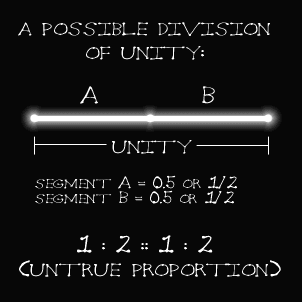- Lesson One: The Number One
- ... in Geometry
- ... in Nature
- ... in Culture
- "Uroboros" (related artwork by the author)
- "Creation" (related artwork by the author)
- Lesson Two: The Square Root of Two
- ... in Geometry
- ... in Nature, Part 1
- ... in Nature, Part 2
- ... in Culture, Part 1
- ... in Culture, Part 2
- "Duality" (related artwork by the author)
- Lesson Three: The Square Root of Three
- ... in Geometry
- ... in Nature
- ... in Culture
- "Vesica" (related artwork by the author)
- Lesson Four: Phi, or the Golden Proportion
- ... Intro, Part 2
- ... Intro, Part 3
- ... in Geometry
- ... in Nature
- ... in Nature, Part 2
- ... in Culture
- "The Flower of Phi" (related artwork by the author)
- Lesson Five: The Five Perfect Solids
- ... Intro, Part 2
- ... The Tetrahedron
- ... The Octahedron
- ... The Cube
- ... The Icosahedron
- ... The Dodecahedron
Phi as an expression of "Ji Ji Mu Ge":
It has been stated several times in the various Lessons that the original state of the universe is a unified one, and at some point that unity divides to create form and movement. But there has also been an insistence throughout this body of literature that the original state of unity is still exists, despite the fact that it has divided into an infinite number of forms. Various explanations have been given to explain this paradox of "ji ji mu ge," or "Thing and thing, no division," but it is with Phi that we find the most apt expression in geometry of the paradox of "one-yet-many, many-yet-one."
Let's take the most simplified geometric expression of Unity - a single straight line - and use it as an experiment for creating simultaneous division and unity. If we were to take our Unity and divide it, we might be tempted to simply divide the line in half:
 Original artwork created by A. O'Connor for Nature's Word using Adobe Photoshop 5.0.
Original artwork created by A. O'Connor for Nature's Word using Adobe Photoshop 5.0.For many this would make a very poetic and just situation, wherein two equal halves exist, neither of which dominates the other. In many ways, this is true - except for one major problem: we now have two halves, with neither containing a proportionate relation to the original unity. Our two segments have the following proportion: 1:2::1:2. As discussed earlier, the proportion is not a true proportion, because nothing has been stated at all. By this we mean that no relationship between two sets of variables has been established, because only one set of variables is relating to itself (1:2), which doesn't make a relational - it makes a simple ratio. All we have now is two halves, both of which relate only to their division (1:2, i.e., one relates to two - period). Thus we have divided unity, but in so doing lost our relation to unity.
From here we would have to start dividing unity using fractions or decimals other than 1/2, or 0.50. Let's try an example, say dividing unity at the 1/4 to 3/4 mark: 0.25:1 :: 0.75:3. Our segments can no longer both be related to the original unity, because if 0.25 is to 1, then in a true proportion, 0.75 has to be multiplied by 4 (the relational as defined by 0.25 to 1), giving us 3. Thus in this example we cannot relate both segments of unity back to unity - only one, which automatically forces the other out of relation to unity.
The same is true for any division of one - there is no way to create a true proportion that will relate both sections back to unity again. Except, of course, the Golden Division.
A:B::B:(A+B), or 0.382:0.618 :: 0.618:1
The two halves are in the same proportion to each other as the greater segment is to the sum of both. There is nothing other than the two segments and the unity that encompasses them in the proportion, and thus we have divided unity into two segments, the both of which can (and do) directly relate back to the original unity in a true proportional sense - both mathematically and figuratively. We have divided unity into multiplicity in such a way that the multiplicity continually relates back to the unity that contains it, and thus an aspect of "ji ji mu ge" has been explained. We shall shortly see the many ways in which the Phi division does indeed lead to infinite multiplicity within unity.
To summarize, geometrically speaking there is only one way to create a proportion that contains only two variables. That proportion, when algebraically reduced, happens to equal the irrational number known as Phi - 0.618... or 1:1.618... Phi "coincidentally" happens to give us an apt expression for the transcendence of humankind, and also gives us the ability to understand how it is possible that the unified universe can be divided into myriad forms, yet continuously relate back to the ever-present unity of all things.
Now wait until you see how nature uses the number...


